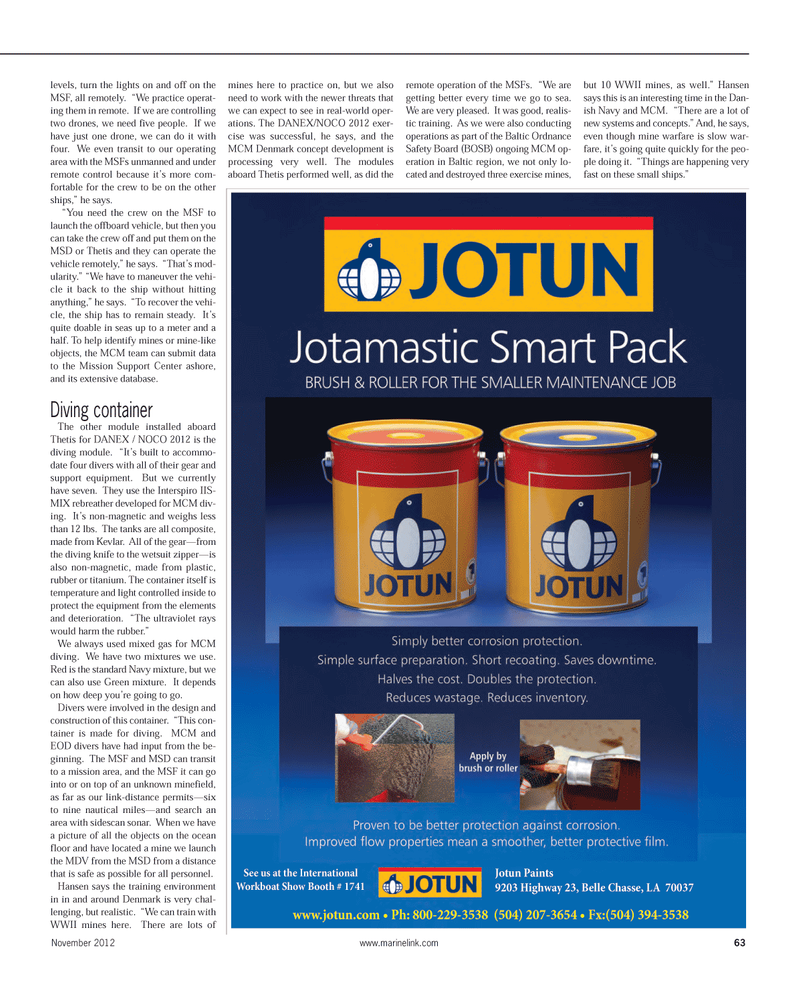
Page 63: of Maritime Reporter Magazine (November 2012)
Workboat Annual
Read this page in Pdf, Flash or Html5 edition of November 2012 Maritime Reporter Magazine
levels, turn the lights on and off on the MSF, all remotely. ?We practice operat- ing them in remote. If we are controllingtwo drones, we need five people. If we have just one drone, we can do it with four. We even transit to our operating area with the MSFs unmanned and underremote control because it?s more com- fortable for the crew to be on the other ships,? he says. ?You need the crew on the MSF to launch the offboard vehicle, but then you can take the crew off and put them on the MSD or Thetis and they can operate the vehicle remotely,? he says. ?That?s mod- ularity.? ?We have to maneuver the vehi- cle it back to the ship without hittinganything,? he says. ?To recover the vehi- cle, the ship has to remain steady. It?s quite doable in seas up to a meter and ahalf. To help identify mines or mine-like objects, the MCM team can submit datato the Mission Support Center ashore,and its extensive database. Diving containerThe other module installed aboardThetis for DANEX / NOCO 2012 is the diving module. ?It?s built to accommo- date four divers with all of their gear and support equipment. But we currentlyhave seven. They use the Interspiro IIS- MIX rebreather developed for MCM div- ing. It?s non-magnetic and weighs less than 12 lbs. The tanks are all composite, made from Kevlar. All of the gear?from the diving knife to the wetsuit zipper?is also non-magnetic, made from plastic,rubber or titanium. The container itself is temperature and light controlled inside toprotect the equipment from the elementsand deterioration. ?The ultraviolet rays would harm the rubber.? We always used mixed gas for MCM diving. We have two mixtures we use. Red is the standard Navy mixture, but we can also use Green mixture. It dependson how deep you?re going to go. Divers were involved in the design and construction of this container. ?This con- tainer is made for diving. MCM and EOD divers have had input from the be- ginning. The MSF and MSD can transit to a mission area, and the MSF it can gointo or on top of an unknown minefield, as far as our link-distance permits?six to nine nautical miles?and search anarea with sidescan sonar. When we have a picture of all the objects on the oceanfloor and have located a mine we launch the MDV from the MSD from a distance that is safe as possible for all personnel.Hansen says the training environment in in and around Denmark is very chal- lenging, but realistic. ?We can train with WWII mines here. There are lots of mines here to practice on, but we also need to work with the newer threats that we can expect to see in real-world oper- ations. The DANEX/NOCO 2012 exer- cise was successful, he says, and the MCM Denmark concept development is processing very well. The modules aboard Thetis performed well, as did the remote operation of the MSFs. ?We are getting better every time we go to sea. We are very pleased. It was good, realis- tic training. As we were also conducting operations as part of the Baltic OrdnanceSafety Board (BOSB) ongoing MCM op-eration in Baltic region, we not only lo- cated and destroyed three exercise mines, but 10 WWII mines, as well.? Hansen says this is an interesting time in the Dan-ish Navy and MCM. ?There are a lot of new systems and concepts.? And, he says, even though mine warfare is slow war- fare, it?s going quite quickly for the peo- ple doing it. ?Things are happening very fast on these small ships.? November 2012www.marinelink.com 63Jotun Paints 9203 Highway 23, Belle Chasse, LA 70037 www.jotun.com ? Ph: 800-229-3538 (504) 207-3654 ? Fx:(504) 394-3538 See us at the International Workboat Show Booth # 1741 MR#11 (58-65):MR Template 11/6/2012 3:36 PM Page 63

 62
62

 64
64
